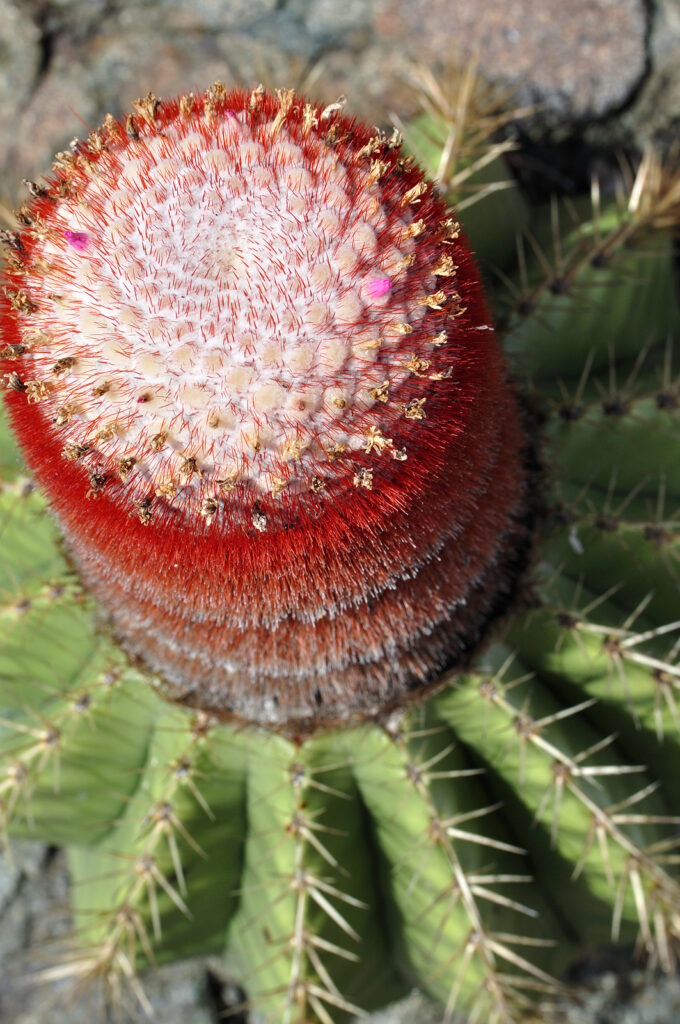Melocactus–commonly called melon cactus or turk’s cap cactus–are heavily ribbed and heavily spined cactus that have globular or longish bodies. Melocactus form, bristly, felty cephalium (similar to a wool cap) which stands more than 3 feet taller than the body of the cactus. Cephalium is a colorful structure of colorful wool and bristles at the growing tip of some cacti.
Mature Melocactus plants bear small pink blooms. Flowers appear in spring and summer during day time and close at night.
Melocactus are temperamental and difficult to grow. They can fail if temperatures drop below 50℉ (10℃). They need porous, rich soil that allows for perfect drainage. They want modest amounts of water and just the right about of heat and light during winter.
Melocactus have a shallow and extremely spreading root system. If they can’t spread as they like, they quit. Melocactus is one of the most difficult cacti to cultivate.
Melocactus is a genus of about 36 species. Melocactus are native to tropical Central America and Brazil.
Get to know Melocactus
- Plant type: Cactus, melon cactus
- Hardiness temperature: 50℉ (10℃); tolerates 65° to 90°F (18° to 32°C) range.
- Shape and size: Grows to more than 3 feet (1m)
- Flowers: Small, reddish flowers
- Bloom time: Summer
- Common name: Melon cactus, turk’s cap cactus
- Genus name: Melocactus
- Family name: Cactaceae
- Origin: Central America and Brazil

Planting Melocactus
- Grow Melocactus in porous, rich, acidic, sandy soil with good drainage; use a cactus mix.
- Grow Melocactus in full sun.
- Indoors give Melocactus bright, filtered light from southern, southeastern, or eastern exposure. Does well under artificial light, needing 12 to 16 light-hours daily. Fresh air circulation is important.
- Melocactus wants warm ground, with humid, warm air.
- Plant Melocactus in a wide container.
How to water and feed Melocactus
- Sprinkle or mist Melocactus frequently; use calcium-free water at room temperature.
- Let soil dry between moderate waterings. Avoid overwatering, which causes rot.
- Do not let Melocactus dry out entirely in winter; keep Melocactus warm.
- For Melocactus without caps use a low-nitrogen, high-potassium fertilizer once in spring. Feed plans with caps every 2 months. Feed established plants only, and only during growing season.
Melocactus care
- Grow Melocactus in a wide container. Melocactus needs room for optimum growth; its roots are shallow and spreading. Repot when roots completely overcrowd pot space.
- Melocactus needs sufficient heat and light even during the winter months.
- Check for aphids, mealybugs, spider mites, scale. Also be alert for fungus disease.
- Melocactus may become dormant in winter. Keep Melocactus in a cool place; water just enough to keep plant from shriveling.
- Propagate Melocactus by seeds.
Melocactus species to grow
- Melocactus bahiensis. Globular form, measuring 4 inches (10 cm) high and 6 inches (15 cm) wide; brown radial spines emerge from areoles.
- M. communis (turk’s cap, melon cactus). Grows to 3 feet tall cactus with a low (2-inch) cephalium; yellowish spines; red or pinkish flowers.
- M. intortus (turk’s cap cactus). Grows to 36 inches (91 cm) tall and 16 inches (41 cm) wide; cephalium grow another 1 foot above the body; spines are reddish brown, about 1 inch long; daytime flowers are pink.
- M. neryl. Small, 6 inch-body topped with 4-inch cephalium; rosy pink flowers are one-inch-long.
- M. matanzanus, miniature Turk’s cap, grows to a scant 3 ½ inches (9 cm) tall and 4 inches (10 cm) wide; curving spines are red, changing to yellow.
- M. oaxacensis. Stems about 6 inches thick, no more than 10 inches high; cephalium is reddish brown but turn gray; blooms are very dark rose.















